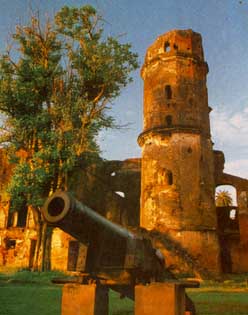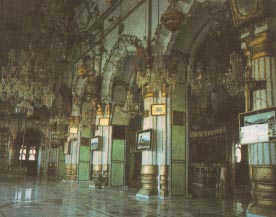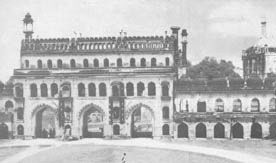
RUMI DARWAZA:
A facsimile of one of the gates
of constantinople, the 60-feet tall Rumi Darwaza was built by Nawab Asaf-ud-Daula
to create employment during the terrible famine of 1784.
RESIDENCY:

Located near the River Bank Colony,
the Residency was built for the British Resident between 1780 and 1800
by Nawab Saadat Ali Khan. Origionally a beautifulbuilding surrounded by
sprawling lawns and terraced gardens, the Residency witnessed a bloody
battle during the first war of Independence in 1857. An English Lobby where
the British took shelter still stands as a silent testimonial to our tumultuous
past.
HUSAINABAD IMAMBARA:
Popularly known as the CHOTA
IMAMBARA,this imposing structure houses the tombs of its builder Mohammad
Ali Shah and of his mother.Gilded mirrors, colourful stucco,chandeliers,
the king's throne and ornate tazia or replicas of the tombs at karbala
adorn the interiors.
ASAFI IMAMBARA:

A beautiful combination of Mugal,
Rajput and gothic architecture,the Asafi Imamabara was built by Nawab Asaf-ud-daula
in 1784.the central hall of the imambara is said to be the largest vaulted
chamber in the World. A staircase from outside lead to a series of labyrinths,which
should best be visited with authorized guides.
SHAHNAJAF IMAMBARA:
Deriving its name from the town
of najaf, near Baghdad where saint Hazrat Ali is buried, the Shahnajaf
Imambara is situated on the right bank of Gomti.Gazi-ud-din Haider and
his wves,including Mubarak Mahal, lie buried in his mausoleon.
CLOCK TOWER:
Constructed in1881, the 221-feet
tall Husainabad Clock Tower has a huge Clock brought from luise gate hill,London,
installed in it.
NATIONAL BOTANICAL RESEARCH INSTITUTE:

The institute has sprawling
gardens and is open to public from 6 a.m. to 5 p.m.. Pitched battles were
fought here during the 1857 revolution.
ZOO/STATE MUSEUM:
Located at Banarsi Bagh,the Prince
of Wales zoological Garden has a large collection of animals.Afavourite
spot for recreation within the zoo is the Lucknow Museum which houses a
large collection of artefacts and memrobilia. Weekely off: Monday
VIDHAN SABHA
It is the Lower house of the state
legislature and was constructed in 1922 at the cost of Rs.1.8 million.
The Shahid Smarak 
It is a tall tower built of marble
on the bank of Gomti. It is a monument built in the memory of the freedom
fighters who laid down their life for the sake of the country. It is very
close to the residency and offers a place to sit next to the Gomti. Boat
rides in the Gomti are also available but is adviseable not to take them.
ALAMBAGH
Compared with many of the historic
buildings in and around Lucknow, the Alam Bagh on the Cawnpore Road
is relatively modern, for it was built by Wajid Ali Shah, the
last king of Oudh. It was built as a country residence for one of
his favourite wives. On July 7, 1857 Havelock proceed with a small
force to relief of Lucknow. An Indian pensioner named Ungud got through
the besieging force several times. carrying letters from Brigadier
Inglis to Sir Henry Havelock at the Alam Bagh. On November 18,
Sir Colin Campbell decided to evacuate the Residency and to leave a strong
force near Alam Bagh. Two days later Havelock fell ill and died in
November 24 in a soldier´s tent in the garden of Dilkusha.
BADSHAH BAGH
King Nasir-ud-Din
Haider, about a 100 years ago, built himself a high-walled
garden which he called the Badshah Bagh. The king is reputed to have included
European beauties in his harem. For them he built the Walaiti Bagh.
Soon Afterwards the Badshah Bagh became the property of the Maharaja of
Kapurthala. In the garden stands a stone cross beneath which lie
the remains of the Eldest son of one of the Maharaja. In 1905 the
Badshah Bagh estate comprising about ninety acres was handed to the authorities
of the Canning College.
BEGUM KOTHI
The Begum Kothi must not be confused
with the house of the same name within the Residency enclosere. It
stand on the left hand side of the Hazrat Ganj, coming from Cantonments.
Untill 1932 the house including a large group of building huddled round
the central one was used as General Post Office. The Begum Kothi was built
by King Amjad Ali Shah in 1844 as a palace for his Queen, Malka Ahad
Begum. The building was not conspicious during the Mutinity untill
March 1858, when two batteries bombared it continously for twenty-four
hours and made two breaches in the wall near where Abott Road now runs.
BIBIAPUR KOTHI
About a mile to the south-east
of Dilkusha lies the Bibiapur Kothi, shielded from viev by the Government
Dairy Farm. The two storeyed building os solid and stand built under
the direction of General Claude Martin for Nawab Asaf-ud-daula who stayed
there from time to time, using it as a hunting box. At
1798 summoning Saádat Ali Khan from Benaras and welcoming him with
as impressive durbar at Bibipur before taking him in procession to the
city where he was proclaimed Nawab.
LUCKNOW BRIDGES
Until the twentieth century there
were but two bridges spanning the Gumti at Lucknow, One iron and
other of stone. The later was begun by the second Nawab, Safdar
Jang or Mansur Ali Khan. The erection of the bridge dragged slowly on.
It was finally completed by the fourth Nawab, Asaf-ud-daulah, Safadar
Jang´s grandson. Above the delicate tracery of the Mosque of
Aurangzeb, abutted upon the more solid outlines of the Machhi Bhawan
Fort. Early in the present century the bridge was condemned as unsafe
and was demolished in 1911 to make way for the Harding Bridge which was
opened on January1, 1914, by Lord Hardinge . At the same
time he performed the inauguration ceremony of the King George´s
Hospital. The iron bridge was conceived by Rennie only twenty years
after the first iron bridge had been made in England. It bears resemblance
to the one designed by by him at Boston, Lincolnshire, over
the river Witham.
CHUTTER MANZIL
Probably everybody knows that the
United Service Club, otherwise the Greater Chutter Munzil,
was once a palace belonging to the King of Oudh. Under the existing
river terrace was the “ground floor” and below that again were the tykhanas,
cooled by the waters of the Gumti which lapped against the outer walls.
Considering their size, surprisingly little is know about the Chutter
Munzil Palaces. The name comes from the gilt “chhuttars” or umbrellas
at the top of the two main buildings. Tradition hints at a
large tank lying between the Greater and lesser Chutter. On November 19
when Sir Colin Campbell decided finally to evacuate the Residency,
the way to freedom lay through the Chutter Palace area from their to the
Moti Mahal.
LUCKNOW SHRINES
Two shrines lie to the south-west
of the Chauk, a point of pilgrimage for many piors Muhammadans at
Moharram time. The more celebrated of the two was erected to Abbas,
an unncle of Ali, who was cousin and son-in-law to the Prophet and
who was killed in the battle of Kerbala. During the Moharram banners are
carried in procession to the shrine, where their with them the sacred
relic, before passing through ther ear gateway. About the hundred
years ago the Dargah was a fine building some five miles from the King´s
Palace. Near the Dargah of Hazrat Abbas is the Talkatora Karbala,
the rendezvous for the Moharram processions from the city for the final
disposal of the tazias. It was built about 1800 by Mir Khuda Baksh
Khan, a Naib of Saádat Ali Khan, and represents the
tomb of Hosein.
DILKUSHA PALACE
The Palace of Dilkusha “Heart´s
Delight” was built by Nawab Saádat Ali Khan 1798-1814. It was erected
as a hunting box in the centre of a large park stocked with all manner
of game that disported among the great trees. Near by lay a large
shallow lake upon which the Nawabs, especially Nasiruddin Haider,
would conduct bird shoots. On November 16 , the force pressed hard on their
adversary´s heels, leaving the eighth foot to garrison Dilkusha.
On November 20, General Havelock fell ill and was taken to Dilkusha.
GREAT IMAMBARA
The Great Imamabara is a stately
building pronounced to be one of the most imposing in the world.
It was built by Nawab Asaf-ud-Daulah in the year 1784 at a cost of a crore
of rupees ( about one million pounds ) Only a few year before his father,
Shuja-ud-Daulah, had transferred his royal residence from Fyzabad
to Lucknow. The disigns of Kifayat-ullah, a well-known architect,
were accepted and the work was commenced. With the exception of the
galleries in tbe interior no wood is used in the construction. The
central apartment is said to be the largest vaulted hall in the world.
It is believed that there is a large underground chambers, but the
passage leading to them have been blocked up since the last century. “Imambara”
is a general term for a building in which the festival of the Moharram
is celebrated, sometime used, as in this case, for a
mausoleum.
TOP









